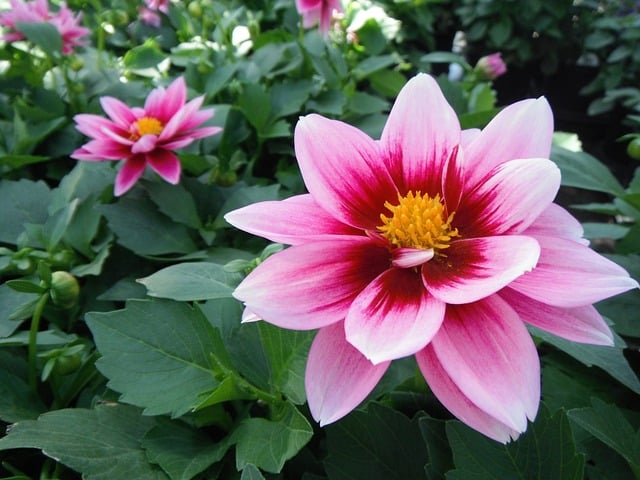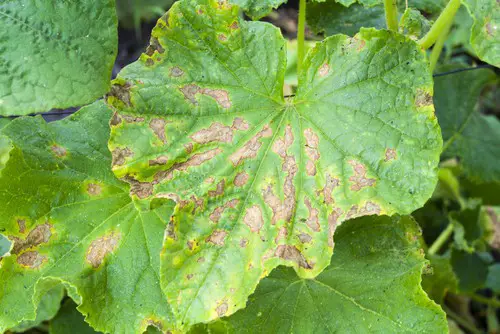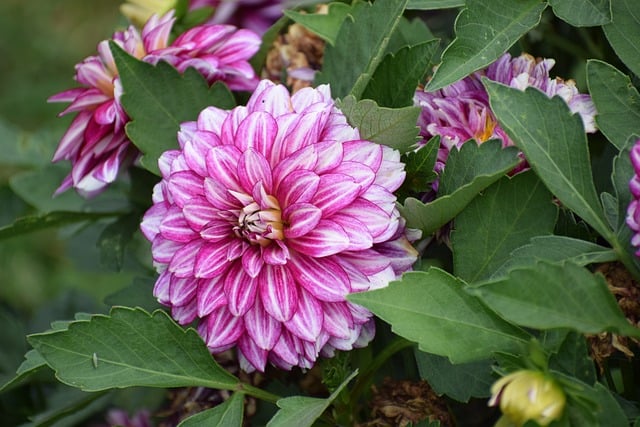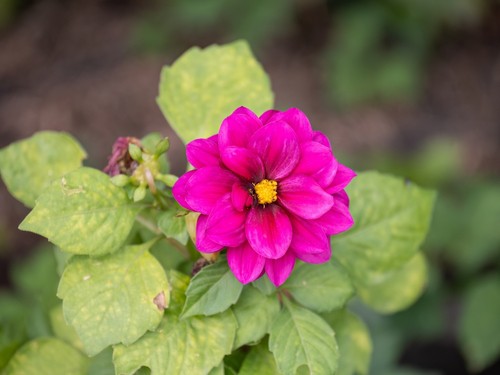Brown spots on dahlia leaves can be a frustrating problem for gardeners. These spots can indicate a variety of issues, from fungal diseases to insect infestations. Understanding the causes of brown spots on dahlia leaves is essential to preventing and treating the problem.
There are several common causes of brown spots on dahlia leaves. Fungal diseases such as gray mold and botrytis can cause brown spots on leaves, flowers, and stems. Pests such as thrips and spider mites can also cause brown spots on dahlia leaves.
Additionally, overwatering or underwatering can cause brown spots on dahlia leaves, as can poor soil quality. By identifying the cause of the brown spots, gardeners can take steps to prevent and treat the problem.
Key Takeaways
- Brown spots on dahlia leaves can indicate a variety of issues, from fungal diseases to insect infestations.
- Common causes of brown spots include fungal diseases, pests, overwatering or underwatering, and poor soil quality.
- Identifying the cause of brown spots is crucial to preventing and treating the problem.
Other popular posts:
Understanding Brown Spots on Dahlias

Brown spots on dahlia leaves are a common problem that gardeners face. These spots can be caused by various factors, including fungal and bacterial infections, pests, and environmental stressors. Understanding the cause of brown spots is essential to prevent further damage to the plant.
1. Fungal and Bacterial Infections
Fungal and bacterial infections are the most common causes of brown spots on dahlia leaves. Botrytis blight is a fungal disease that causes brown, water-soaked spots that enlarge and develop a fuzzy, gray or tan mold as the disease progresses.
Bacterial wilt and soft rot are bacterial diseases that cause brown spots on dahlia leaves. Aster yellows is another bacterial disease that causes brown spots on the leaves.
2. Pests
Pests such as spider mites and thrips can also cause brown spots on dahlia leaves. Spider mites are tiny, sap-sucking pests that cause yellowing and browning of leaves. Thrips are tiny insects that feed on the leaves and cause brown spots.
3. Environmental Stressors
Environmental stressors such as overwatering, underwatering, and exposure to extreme temperatures can also cause brown spots on dahlia leaves. Overwatering can cause root rot, which can lead to brown spots on the leaves.
Underwatering can cause the leaves to dry out and turn brown. Exposure to extreme temperatures, especially high temperatures, can cause the leaves to wilt and turn brown.
To prevent brown spots on dahlia leaves, it is important to maintain good plant hygiene, provide adequate water and nutrients, and monitor the plant for pests and diseases.
Removing infected leaves and debris from around the plant can also help prevent the spread of disease. Fungicides and pesticides can be used as a last resort if the problem persists.
Brown Spots on Dahlia Leaves – 5 Common Problems
Brown spots on dahlia leaves are a common problem that gardeners encounter. These spots can be caused by various factors, including fungal diseases, bacterial diseases, viral diseases, insect infestation, and environmental factors.
1. Fungal Diseases

Fungal diseases are one of the most common causes of brown spots on dahlia leaves. The most common fungal disease that causes brown spots is powdery mildew. This disease appears as white or gray powdery spots on the leaves, which eventually turn brown.
Another fungal disease that causes brown spots is botrytis (gray mold). This disease appears as water-soaked spots that enlarge and develop a fuzzy, gray or tan mold.
2. Bacterial Diseases
Bacterial diseases are another common cause of brown spots on dahlia leaves. The most common bacterial disease that causes brown spots is bacterial wilt. This disease causes the leaves to wilt and turn brown.
Another bacterial disease that causes brown spots is soft rot. This disease causes the leaves to become water-soaked and eventually turn brown.
3. Viral Diseases
Viral diseases can also cause brown spots on dahlia leaves. The most common viral disease that causes brown spots is dahlia mosaic. This disease causes the leaves to develop yellow or white spots, which eventually turn brown.
4. Insect Infestation
Insect infestation is another common cause of brown spots on dahlia leaves. Insects such as thrips and aphids can cause brown spots by feeding on the leaves. Spider mites can also cause brown spots by sucking the sap from the leaves.
5. Environmental Factors
Environmental factors can also cause brown spots on dahlia leaves. Overwatering or underwatering can cause the leaves to turn brown. Too much shade can also cause brown spots by limiting the amount of sunlight the plant receives. Sunburn can also cause brown spots by scorching the leaves.
Preventing Brown Spots
Dahlia leaves can develop brown spots due to various reasons such as fungal diseases, pests, or environmental factors. However, with proper care and maintenance, you can prevent brown spots from appearing on your dahlia leaves.
1. Proper Watering

Overwatering or underwatering your dahlia plants can lead to brown spots on the leaves. Dahlia plants require consistent moisture, but not waterlogged soil. Water your dahlia plants thoroughly once or twice a week, depending on the weather and soil conditions. Ensure that the soil is well-draining and does not retain excess water.
2. Adequate Sunlight
Dahlia plants require full sun to thrive and produce healthy foliage. Lack of sunlight can weaken the plants and make them more susceptible to diseases and pests. Therefore, plant your dahlia in a location that receives at least 6 hours of direct sunlight per day.
3. Appropriate Fertilization
Dahlia plants require regular fertilization to promote healthy growth and prevent nutrient deficiencies. Use a balanced fertilizer that contains equal amounts of nitrogen, phosphorus, and potassium. Apply the fertilizer once a month during the growing season, following the manufacturer’s instructions.
4. Air Circulation
Good air circulation is essential for preventing fungal diseases that can cause brown spots on dahlia leaves. Avoid overcrowding your plants, and space them at least 18 inches apart. Prune any dead or diseased foliage to promote air circulation and reduce the risk of fungal infections.
5. Soil Quality
Healthy soil is essential for healthy dahlia plants. Use well-draining soil that is rich in organic matter, such as compost or aged manure. Test the soil pH and adjust it to the optimal range of 6.0 to 6.5. Avoid using soil that has been contaminated with fungal spores or other pathogens.
By following these tips, you can prevent brown spots from appearing on your dahlia leaves and ensure that your plants remain healthy and vibrant throughout the growing season.
Treatment of Brown Spots
Dahlia leaves can develop brown spots due to various reasons, including fungal infections, bacterial infections, or environmental stress. Brown spots can spread quickly and cause the plant to weaken and eventually die. Therefore, it is crucial to treat brown spots as soon as they appear.
1. Use of Fungicides

Fungicides can be used to treat brown spots caused by fungal infections. There are many types of fungicides available in the market, and the choice of fungicide depends on the severity of the infection. Systemic fungicides are the most effective, as they are absorbed by the plant and protect it from future infections.
It is important to follow the instructions on the fungicide label carefully. Overuse of fungicides can cause harm to the plant and the environment. It is also important to wear protective gear, such as gloves and a mask, when applying fungicides.
2. Neem Oil Application
Neem oil is a natural insecticide and fungicide that can be used to treat brown spots caused by fungal infections. Neem oil works by disrupting the fungal cell membrane, preventing its growth.
To use neem oil, mix it with water according to the instructions on the label. Spray the mixture onto the affected leaves, making sure to cover both sides of the leaves. Repeat the application every seven to ten days until the brown spots disappear.
3. Pruning Infected Leaves
Pruning infected leaves is an effective way to prevent the spread of brown spots. Use clean, sharp scissors to cut off the infected leaves, making sure to cut at least one inch below the brown spot. Dispose of the infected leaves in a sealed plastic bag to prevent the spread of the disease.
It is important to sterilize the scissors after each use to prevent the spread of the disease. Dip the blades in a solution of 10% bleach or alcohol for five minutes before using them again.
Caring for Dahlias Throughout the Year
Dahlias are beautiful flowers that require proper care throughout the year to thrive. Here are some tips for caring for your dahlias during each season.
1. Spring Care
In the spring, it’s important to prepare the soil for planting. Dahlias prefer well-drained soil with a pH between 6.5 and 7.0. If your soil is too acidic, add lime to raise the pH. If it’s too alkaline, add sulfur to lower the pH.
Before planting, make sure the soil is moist but not waterlogged. Plant the tubers about 6 inches deep and 18 inches apart. As the plants grow, provide support with stakes or cages to prevent them from falling over.
2. Growing Season Maintenance

During the growing season, it’s important to keep the plants healthy and strong. Water them regularly, but be careful not to overwater, as this can cause root rot. Fertilize the plants every two weeks with a balanced fertilizer to promote growth and blooming.
Mulch around the plants to help retain moisture and suppress weeds. This will also help regulate the soil temperature, which is important for photosynthesis.
Pinch off the top of the plant when it reaches about 12 inches tall to promote branching and more blooms. Deadhead the spent blooms regularly to encourage more blooming throughout the season.
3. Winter Preparations
In the fall, it’s important to prepare the plants for winter. As the first frost approaches, cut back the foliage to about 6 inches above the ground. Carefully dig up the tubers and gently remove any excess soil.
Allow the tubers to dry in a warm, dry place for a few days. Then, store them in a cool, dry place for the winter. Check on them periodically to make sure they’re not rotting or drying out.
By following these tips, you can ensure that your dahlias will thrive throughout the year and provide you with beautiful blooms all season long.
Common Dahlia Varieties and Their Susceptibility to Diseases
Dahlias come in a variety of forms, sizes, and colors, making them a popular choice among gardeners. However, different varieties have varying levels of susceptibility to diseases. Here are some common dahlia varieties and their susceptibility to diseases:
- Single-flowered dahlias: These dahlias have a single row of petals around a central disc. They are generally more resistant to diseases than other varieties.
- Anemone-flowered dahlias: These dahlias have a central disc surrounded by one or more rows of flat petals. They are susceptible to powdery mildew and botrytis.
- Collarette dahlias: These dahlias have a single row of petals around a central disc, with a second row of shorter petals around the outer edge. They are susceptible to powdery mildew and botrytis.
- Decorative dahlias: These dahlias have fully double flowers with broad petals that curve inward. They are susceptible to verticillium wilt, fusarium wilt, and botrytis.
- Cactus dahlias: These dahlias have narrow, pointed petals that curve backward. They are susceptible to verticillium wilt and botrytis.
- Pompon dahlias: These dahlias have small, ball-shaped flowers with tightly packed petals. They are generally more resistant to diseases than other varieties.
- Waterlily dahlias: These dahlias have fully double flowers with broad, overlapping petals that curve outward. They are susceptible to botrytis.
It’s important to note that while some varieties may be more resistant to certain diseases than others, all dahlias are susceptible to some degree of disease. Gardeners should take preventative measures such as proper watering, good air circulation, and regular inspections to catch and treat diseases early.
Conclusion

In conclusion, brown spots on dahlia leaves can be caused by a variety of factors, including fungal diseases, overwatering, underwatering, and insect infestations. It is important to identify the cause of the brown spots in order to treat the problem effectively.
Prevention is key when it comes to brown spots on dahlia leaves. This includes proper watering techniques, avoiding overhead watering, and providing adequate air circulation around the plants. Regularly inspecting the plants for signs of pests or disease can also help prevent brown spots from developing.
If brown spots do appear on dahlia leaves, prompt action is necessary to prevent the spread of disease. This can include removing infected leaves, treating the plant with fungicides or insecticides, and adjusting watering practices as needed.
Overall, with proper care and attention, dahlia plants can be kept healthy and free of brown spots. By identifying and addressing the underlying causes of brown spots, gardeners can enjoy beautiful, vibrant dahlia blooms year after year.
Frequently Asked Questions
Why are my dahlia flowers turning brown?
Dahlia flowers turning brown can be caused by a variety of reasons, including overwatering, underwatering, fungal diseases, or insect infestations. It is important to identify the underlying cause of the problem to determine the appropriate treatment.
How do you treat fungus on dahlias?
Fungal diseases can cause brown spots on dahlia leaves. To treat fungus on dahlias, it is important to remove any infected leaves and dispose of them properly.
Fungicides can also be applied to the plant to prevent further spread of the disease. It is important to follow the instructions on the fungicide label carefully.
What does thrip damage look like on dahlias?
Thrips are small insects that can cause damage to dahlias. Thrip damage on dahlias can appear as silvery or bronzed patches on the leaves, and the flowers may have a distorted or discolored appearance.
In severe cases, the plant may become stunted or fail to bloom. Insecticides can be used to control thrips on dahlias.
What are some common dahlia leaf diseases?
Some common dahlia leaf diseases include bacterial disease, wilt, soft rot, aster yellows, powdery mildew, gray mold, Verticillium & Fusarium Wilt, and smut. It is important to identify the specific disease affecting the plant to determine the appropriate treatment.
What are the symptoms of overwatered dahlias?
Overwatering can cause brown spots on dahlia leaves and can lead to root rot. Symptoms of overwatered dahlias include yellowing leaves, wilting, and a mushy or rotten smell from the soil. To prevent overwatering, it is important to allow the soil to dry out slightly between waterings.
How can I prevent dahlia ring spot?
Dahlia ring spot is a viral disease that can cause brown spots on dahlia leaves. To prevent dahlia ring spot, it is important to plant disease-resistant varieties and practice good garden hygiene, such as removing any infected plant debris and disinfecting gardening tools between uses.

Hey, I’m Lisa and I’ve been an avid gardener for over 30 years. I love writing, talking and living in the garden! Feel free to connect with me on my socials below

